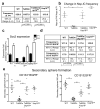Usp16 contributes to somatic stem-cell defects in Down's syndrome
- PMID: 24025767
- PMCID: PMC3816928
- DOI: 10.1038/nature12530
Usp16 contributes to somatic stem-cell defects in Down's syndrome
Abstract
Down's syndrome results from full or partial trisomy of chromosome 21. However, the consequences of the underlying gene-dosage imbalance on adult tissues remain poorly understood. Here we show that in Ts65Dn mice, which are trisomic for 132 genes homologous to genes on human chromosome 21, triplication of Usp16 reduces the self-renewal of haematopoietic stem cells and the expansion of mammary epithelial cells, neural progenitors and fibroblasts. In addition, Usp16 is associated with decreased ubiquitination of Cdkn2a and accelerated senescence in Ts65Dn fibroblasts. Usp16 can remove ubiquitin from histone H2A on lysine 119, a critical mark for the maintenance of multiple somatic tissues. Downregulation of Usp16, either by mutation of a single normal Usp16 allele or by short interfering RNAs, largely rescues all of these defects. Furthermore, in human tissues overexpression of USP16 reduces the expansion of normal fibroblasts and postnatal neural progenitors, whereas downregulation of USP16 partially rescues the proliferation defects of Down's syndrome fibroblasts. Taken together, these results suggest that USP16 has an important role in antagonizing the self-renewal and/or senescence pathways in Down's syndrome and could serve as an attractive target to ameliorate some of the associated pathologies.
Figures





Comment in
-
Stem cells: Down's syndrome link to ageing.Nature. 2013 Sep 19;501(7467):325-6. doi: 10.1038/nature12558. Epub 2013 Sep 11. Nature. 2013. PMID: 24025769 No abstract available.
-
Usp16: key controller of stem cells in Down syndrome.EMBO J. 2013 Oct 30;32(21):2788-9. doi: 10.1038/emboj.2013.220. Epub 2013 Sep 27. EMBO J. 2013. PMID: 24076652 Free PMC article.
References
-
- Antonarakis SE, Lyle R, Dermitzakis ET, Reymond A, Deutsch S. Chromosome 21 and down syndrome: from genomics to pathophysiology. Nat. Rev. Genet. 2004;5:725–738. - PubMed
-
- Yang Q, Rasmussen SA, Friedman JM. Mortality associated with Down’s syndrome in the USA from 1983 to 1997: a population-based study. Lancet. 2002;359:1019–1025. - PubMed
-
- Zigman WB, Lott IT. Alzheimer’s disease in Down syndrome: neurobiology and risk. Ment Retard Dev Disabil Res Rev. 2007;13:237–246. - PubMed
Publication types
MeSH terms
Substances
Grants and funding
LinkOut - more resources
Full Text Sources
Other Literature Sources
Medical
Molecular Biology Databases
Miscellaneous

